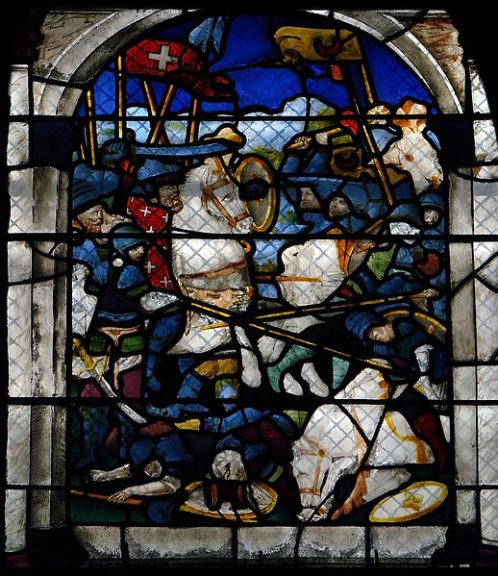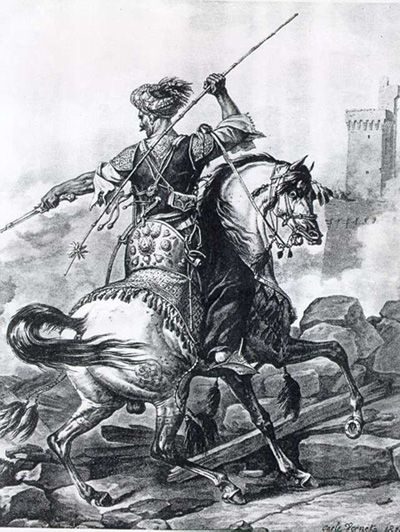At daybreak the whole fleet weighed anchor, and the Mussulmans at the same time got under arms. Their infantry and cavalry occupied the entire shore of the point at which they expected the Crusaders to land.
When the vessels drew near the shore, the Christian warriors got into the barks that accompanied the fleet, and ranged themselves in two lines. Louis IX, accompanied by the two princes his brothers, and his chosen knights, placed himself at the right point. The cardinal legate, bearing the cross of the Savior, was on his right hand, and in a bark in front of him floated the oriflamme of France.

Stained glass window of the Militant Church, late 16th century. Detail: the battle of Mansourah (during the 7th crusade led by Saint Louis, in 1250).
The count of Jaffa, of the illustrious family of Brienne, was at the left point towards the mouth of the Nile; he appeared at the head of the knights from the isle of Cyprus and the barons of Palestine. He was on board the lightest bark of the fleet. This boat bore the arms of the counts of Jaffa, painted on its poop and prow. Around his standard floated banderoles of a thousand colors, and three hundred rowers impelled the vessel through the waves like the flight of the swallow over the stream. Erard of Brienne, surrounded by a chosen troop, occupied the center of the line, with Baldwin of Rheims, who commanded a thousand warriors. The knights and barons stood erect in their boats, looking earnestly at the shore, lance in hand, with their horses beside them. In the front and on the wings of the army, a crowd of crossbow-men were placed to keep off the enemy.

Capturing Damietta painted by Cornelis Claesz. van Wieringen. This painting was taken from the largest wall tapestry of the 17th century depicting “The Ship of Damiate”. This tapestry which hangs in the Haarlem City Hall, in Haarlem, the Netherlands, is 35 feet long by 7 feet high.
As soon as they were within bowshot, a shower of stones, arrows, and javelins was poured at the same instant from the shore and from the line of the Crusaders. The ranks of the Christians appeared for a moment shaken. The king commanded the rowers to redouble their efforts to gain the shore. He himself set the first example; in spite of the legate, who endeavoured to restrain him, he plunged into the waves, in full armor, his buckler over his breast, and his sword in hand; the water being up to his shoulders; the whole Christian army, after the example of the king, cast themselves into the sea, crying “Montjoie! St. Denis!” This multitude of men and horses, endeavoring to gain the shore, elevated the waves which broke at the feet of the Saracens; the warriors pressed on, clashing against each other in their progress—nothing was heard but the noise of the waves and the oars, the cries of the soldiers and the sailors, and the tumultuous shock of the barks and vessels, which advanced in disorder.
The Mussulman battalions assembled on the shore could not stop the French warriors. Joinville and Baldwin of Rheims landed the first; after them came the count of Jaffa. They were drawing up in order of battle, when the cavalry of the Saracens came pouring down upon them; the Crusaders closed in their ranks, covered themselves with their bucklers, and presenting the points of their lances, checked the impetuosity of the enemy. All their companions who had reached the shore, immediately formed in rear of this battalion.
Already the oriflamme was planted on the shore; Louis had landed. Without giving the least reflection to the danger, he immediately fell on his knees to offer up his thanks to Heaven; and springing up again, filled with fresh ardor, called his bravest knights around him. An Arab historian relates that the king of the Franks then caused his tent to be pitched, which was of bright scarlet, and attracted all eyes. At length, all the army being landed, a sanguinary contest began on every part of the coast; the Saracens and Franks, seeking and attacking each other, formed one conflicting mass. Nobody remained inactive; the two fleets quickly became engaged at the mouth of the Nile. Whilst the shore and the sea resounded thus with the shock of arms, Queen Marguerite and the duchess of Anjou, who remained on board a vessel at a distance, awaited in terrible anxiety the issue of the double battle; they offered up fervent prayers, and pious ecclesiastics assembled around them, joined in holy psalms to obtain the protection of the God of armies.
The fleet of the Saracens was soon dispersed; many of the vessels were sunk, the remainder escaped up the river. In the mean time, the troops of Fakreddin, broken in all directions, retired in the greatest confusion; the French pursuing them up to their entrenchments. After a last desperate struggle, the Mussulmans abandoned their camp and the western bank of the Nile, leaving several of their emirs on the field of battle: nothing could resist the French, animated by the presence and the example of their king.
Joseph François Michaud, History of the Crusades, trans. W. Robson (London: George Routledge and Co., 1852), 2:382 –4.
Short Stories on Honor, Chivalry, and the World of Nobility—no. 744









